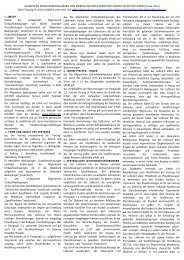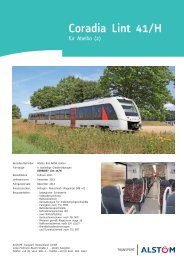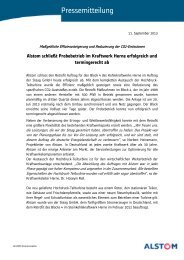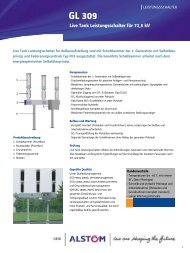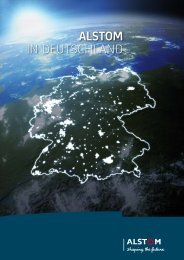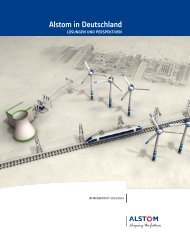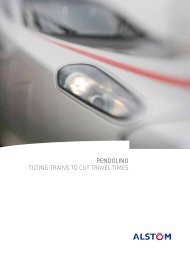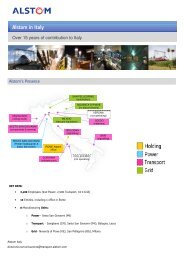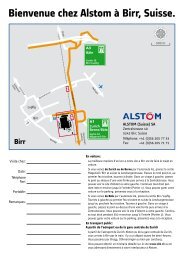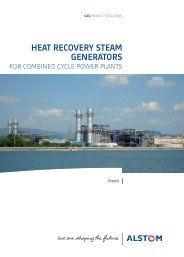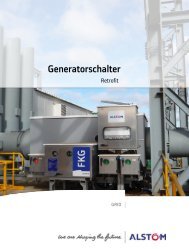MOROCCO IS ACCELERATING! feature - Alstom
MOROCCO IS ACCELERATING! feature - Alstom
MOROCCO IS ACCELERATING! feature - Alstom
You also want an ePaper? Increase the reach of your titles
YUMPU automatically turns print PDFs into web optimized ePapers that Google loves.
32<br />
society<br />
�<br />
limited physical space, is a headache:<br />
“One of our problems today with the Eurostar<br />
is that we can receive two Eurostars an hour<br />
at Paris-Nord, when the line has capacity<br />
for three trains an hour…”<br />
… managed<br />
in a compartmented manner<br />
Although the twenty-fi rst century station<br />
houses twentieth century transport services,<br />
its political role in structuring the territory<br />
and society, has not changed. The station<br />
connects several worlds. Restructuring<br />
a French station is a particularly diffi cult task<br />
as authority has been divided up by<br />
the Loi d’orientation des transports intérieurs.<br />
A single station is therefore answerable to:<br />
different transport authorities: the SNCF<br />
for mainlines, the region for regional transport,<br />
the department for departmental lines<br />
and the urban area or communauté<br />
de communes for local lines;<br />
different owners: the RFF*, the SNCF,<br />
the city authority for the station square,<br />
state departments (Facilities, Defense, etc.)<br />
for the area behind the station;<br />
different operators: transporters (rail<br />
transport or not, collective or not), retailers…<br />
Fabienne Keller underlines how diffi cult<br />
this partitioning makes project management:<br />
“The modernisation of the TGV station<br />
at Le Mans, for example, despite its relative<br />
simplicity, required 48 property changes!<br />
These are all factors liable to slow<br />
down projects. Faced by this legal division,<br />
the solution is to create a structure<br />
– public institution, mixed enterprise, etc. –<br />
able to mutualise properties, distribute<br />
functions in an optimum manner and give<br />
each entity a claw-back provision. This system<br />
permits legal reunifi cation of the area.”<br />
For this purpose, the SNCF, the regions and<br />
local actors would like to strengthen their ties.<br />
Bringing all the actors together to render<br />
projects more fl exible is a major challenge<br />
because stations, for several reasons,<br />
are a particular priority for rail investment:<br />
fi rst, they are sometimes wasteland, then,<br />
their number of users is likely to grow fourfold<br />
over the next twenty years, as a result<br />
* RFF: national rail infrastructure operator.<br />
of the growth in regional transport under<br />
a policy of sustainable development.<br />
Lastly, as part of the same philosophy,<br />
station development permits urban planning<br />
for an entire surrounding district. “These types<br />
of development projects cost a lot,” agrees<br />
Fabienne Keller, “and concern not only<br />
the transport authorities, but all the actors<br />
who create the city. Since my report<br />
to the Prime Minister, I am regularly<br />
approached to take part in symposiums or<br />
by city authorities seeking the most effi cient<br />
manner to get different actors to work<br />
together on these projects. I also have fairly<br />
frequent contact with economic stakeholders,<br />
who are of interest for three reasons:<br />
they provide fi nance for co-fi nancing, generate<br />
jobs and create activities.”<br />
This division of responsibility also leads<br />
to a division of pricing for services provided.<br />
With the exception of the Ile-de-France,<br />
managed by a single authority concerned<br />
with maintaining integrated pricing, the law<br />
separating organisations and dividing up<br />
operators has permitted the proliferation of<br />
different pricing systems and different pricing<br />
offers, preventing the traveller from buying<br />
a ticket valid for their entire journey, from end<br />
to end. “Paradoxically, passengers are less<br />
well treated than their luggage, which is<br />
collected at their homes and transported<br />
to the point of destination for a single price!”<br />
the Senator remarks ironically.<br />
A new ‘signposting language’<br />
In the complex world of the great station, how<br />
can the time spent by the customer be made<br />
as pleasant as possible? Gares & Connexions<br />
are developing a range of solutions. First,<br />
those that Sophie Boissard calls the ‘basics’,<br />
intended to create a calm atmosphere<br />
in the station. This includes the building’s<br />
architectural quality and the quality of its<br />
lighting, which should as often as possible<br />
be natural lighting, and its acoustic ambiance:<br />
“French stations are still too noisy compared<br />
with those in Germany or Switzerland, where<br />
there are practically no voice announcements<br />
anymore,” she observes. The fi eld of<br />
investigation also covers thermal comfort,



